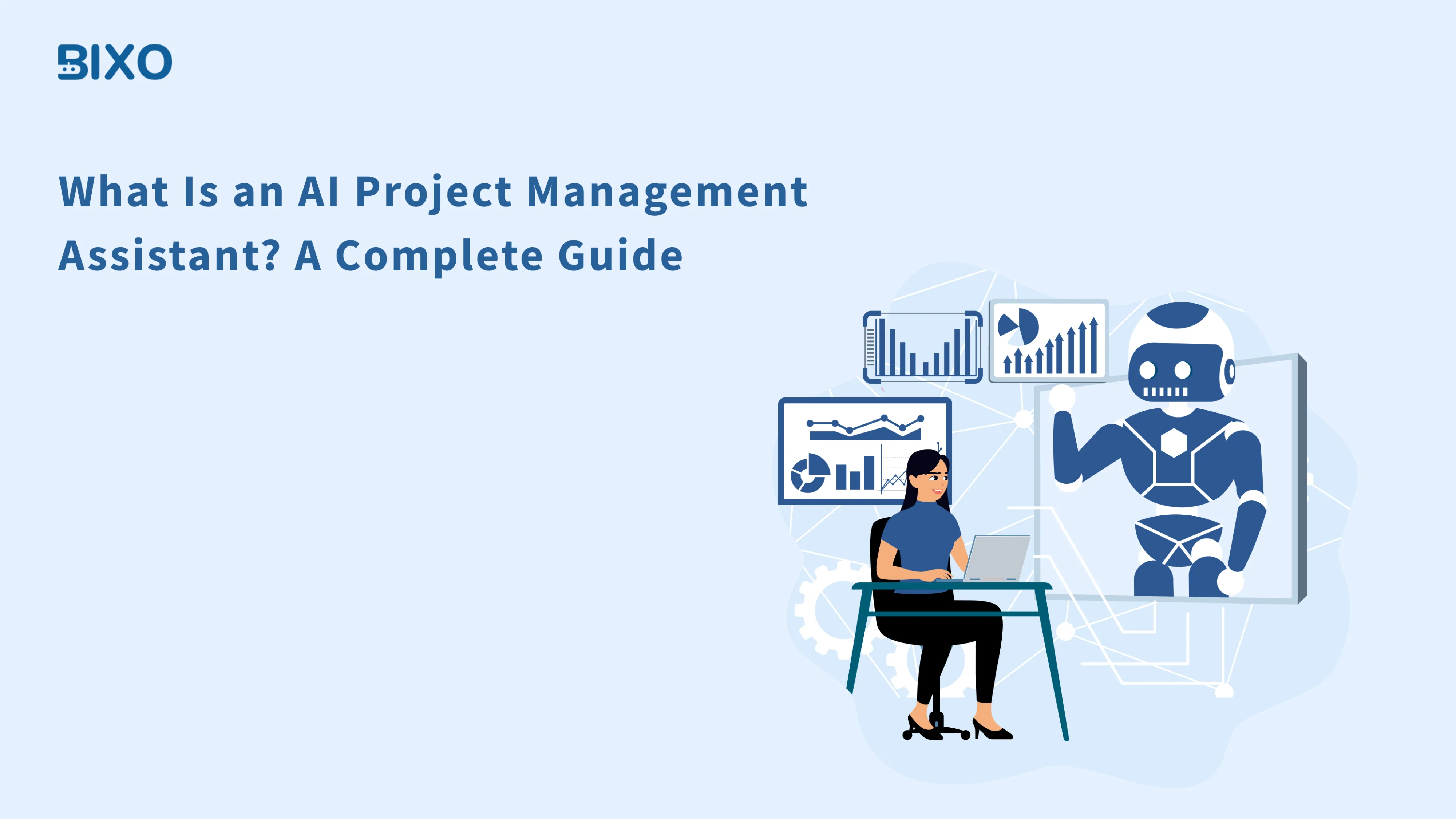
Table of Content
Focus on what matters. BIXO handles the rest!

If your day feels full but the important stuff still doesn’t get done, you’re not alone. Learning how to prioritise your tasks is what helps you move from just being busy to making real progress. It’s not just about getting things done, but it’s about doing the right things at the right time.
Whether you’re handling deadlines, meetings, or a long to-do list, knowing how to prioritise tasks effectively can help you stay focused. In this blog, you’ll discover easy and practical ways to prioritise your tasks and help you stay organised, work smarter, and finish more work within deadlines.
5 Simple Steps to Prioritise Your Tasks Effectively
Getting things done isn’t about working harder; it’s about knowing what to focus on first. When everything feels urgent, it’s easy to waste time on the wrong tasks. That’s where prioritisation comes in. By following these five simple steps, you’ll know exactly what matters most, stay organised, and make real progress without feeling overwhelmed.

Step 1 – List All Your Tasks
Start by writing down everything you need to do. Big tasks, small ones, urgent ones or things that can wait. Put everything that is on your mind onto a list. The goal is to see everything clearly. Without the full picture, you’ll just be guessing what to do next.
You can use a notebook, an app, or any tool you like. What matters is having all your tasks in one place. It’s much easier to plan when you know exactly what’s on your plate and what tasks you need to do.
Step 2 – Identify What’s Truly Important
Now that you’ve written everything down, take a close look. Some tasks can wait, but others need to be done right now.
Ask yourself:
- What’s going to help me get there?
- What’s going to cause issues if I ignore it?
This is what you need to do here. Picking out the stuff that actually matters and leaving the rest for later. You don’t need a tool for this. Just be straight with yourself about what’s worth doing now and what can wait.
Step 3 – Choose a Prioritisation Method
Once you’ve identified the important tasks, decide how you want to organise them. There’s no one best way. Just use the method that feels right for you.
Here are some easy ways to try:
- The Eisenhower Matrix helps you figure out what needs to be done now and what can wait.
- The Ivy Lee Method helps you focus on your top six tasks each day.
- The ABCDE Method puts tasks into five groups. A is very important, B is important, C is good to do if you have time, D can be done by someone else, and E can be left out.
Having a clear way to order tasks makes it easier to stay focused and stops you from wasting time figuring out what to do next.
Step 4 – Organise Your Day Around Priorities
Take your top tasks and block time for each one in your project schedule. Don’t just make a list. Set time aside for each task. You can use a notebook, a calendar app, or any tool that helps you plan your day. Try to do the most important work when you have the most energy, usually earlier in the day. Do easier or less urgent tasks later.
This step turns your plans into real progress. Without it, even the best list won’t help you get things done. Having a clear way to order tasks makes it easier to stay focused and stops you from wasting time figuring out what to do next.
Step 5 – Review and Adjust as Needed
Good task management means checking in regularly, either at the end of each day or at least once a week. Things change. Project plans shift. New tasks come in. That’s why you can’t just make a to-do list and forget about it.
Look at what you finished, what’s still left, and what needs to change. Maybe something that felt urgent isn’t important anymore. Maybe something new needs to move up. Staying flexible helps you keep focused and avoid getting stuck in yesterday’s plan.
H2: 7 Proven Task Prioritisation Techniques
Here are 7 simple task prioritisation techniques to help you sort your tasks and get more done without feeling stressed.
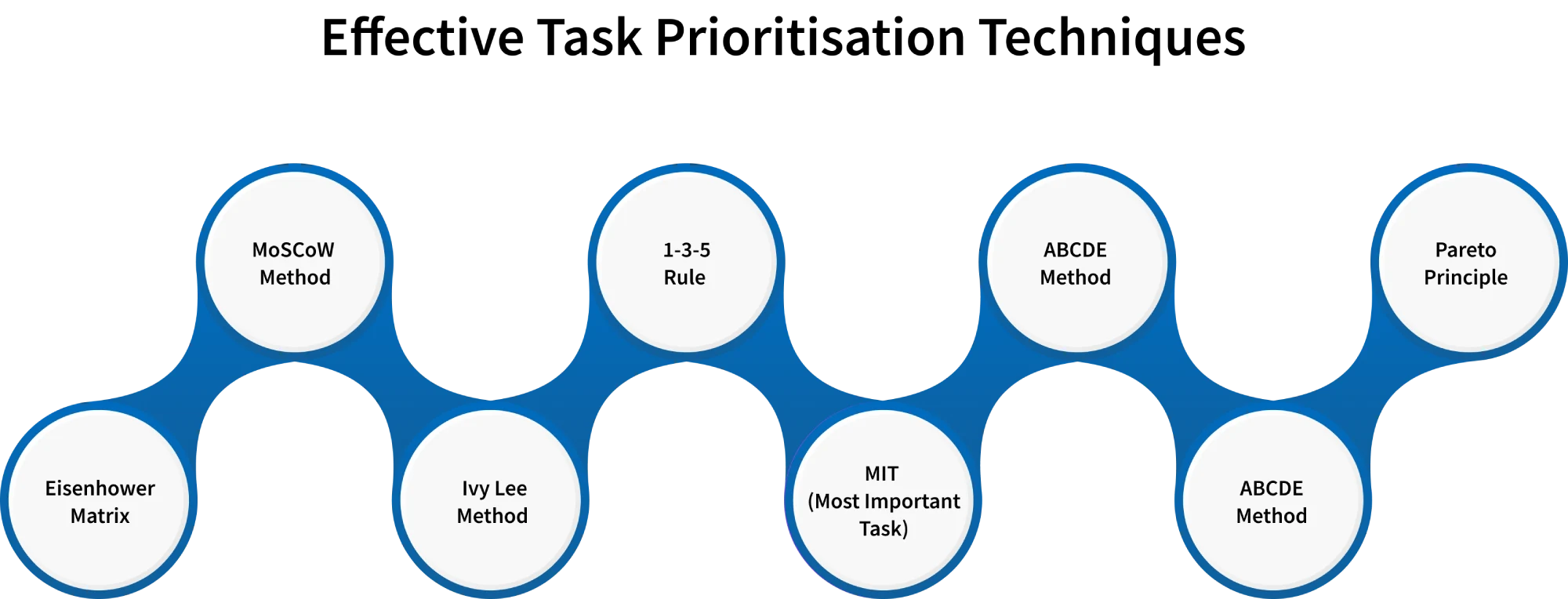
1. Eisenhower Matrix
The Eisenhower Matrix helps you tell the difference between what really matters and what just takes up your time. You sort your tasks into four groups: urgent and important, important but not urgent, urgent but not important, and neither urgent nor important. This method helps you stop jumping at every task and start thinking about where your time should really go.
If you're trying to figure out how to prioritise tasks at work, using the Eisenhower matrix technique gives you a clear way to see what to do first, what to schedule for later, what to hand off, and what to skip. It’s a simple task prioritisation technique that helps you stay focused and manage your day better.
2. MoSCoW Method
The MoSCoW Method is an easy way to prioritise your tasks when you have too much to handle. You sort everything into four groups: Must-haves (the things you absolutely need to do), Should-haves (important, but not urgent), Could-haves (nice if there’s time), and Won’t-haves (not needed right now).
It’s usually used for managing projects, but you can use it for your personal tasks too. This task prioritisation technique helps you see what really matters, so you’re not treating everything like it’s equally important. If you’re feeling pulled in too many directions, this method helps you stay focused and work on what actually moves things forward.
3. Ivy Lee Method
The Ivy Lee Method is an easy way to prioritise your tasks without making it complicated. At the end of each day, write down the six most important things you need to do tomorrow. Rank them in order, starting with the most important. The next day, begin with the first task and don’t move on until you finish it. Then go to the next one, and so on.
Keeping it to just six tasks helps you stay focused on what really matters. Doing one thing at a time also helps avoid distractions. If your to-do list feels never-ending, this task prioritisation technique gives you a clear and simple way to stay on track.
4. 1-3-5 Rule
The 1-3-5 Rule is an easy way to plan your day without feeling stressed. You pick 1 big task, 3 medium ones, and 5 small ones. That’s your to-do list, with nothing more and nothing less. It helps you stay focused and avoid trying to do too much at once. You still get to choose what matters most, but with limits that make your day more manageable. It’s a simple system that helps you get things done without overloading yourself.
5. MIT (Most Important Task)
Start your day by picking one task that matters the most and the one that really moves your work forward. Get that task done first, before anything else takes up your time or energy. This method works well because it helps you focus on what’s important instead of just staying busy. If everything feels urgent and you don’t know where to start, this approach makes things clear. It’s a simple task prioritisation method that helps you stay focused and get meaningful work done.
6. ABCDE Method
The ABCDE Method is a simple method of determining what requires your time first. All you have to do is take your list of tasks and mark them. ‘A' is for the stuff that really matters and needs to get done right away. ‘B’ is still important, but not urgent. ‘C’ is something you could do if there’s extra time, but it’s not going to change anything if you don’t. ‘D’ is something you can hand off to someone else, and 'E’ is what you can skip completely.
You start with the 'A' tasks and don’t move down the list until they’re done. It’s a simple way to stop guessing and start focusing on what actually moves things forward.
7. Pareto Principle (80/20 Rule)
This method is based on a simple idea: 80% of your results come from just 20% of your work. In other words, a few important tasks make the biggest difference. Your job is to figure out which tasks really move things forward and spend most of your time on those.
For example, one or two main projects might give you most of your success, while the rest just keep you busy. This technique helps you focus on important things first instead of trying to do everything. You’re not just working, and mainly, you’re making real progress. It’s a smart way to stay productive without feeling overwhelmed.
What Are the Common Mistakes That Hold You Back in Task Prioritisation?
Here are some common mistakes that can slow you down without you noticing.
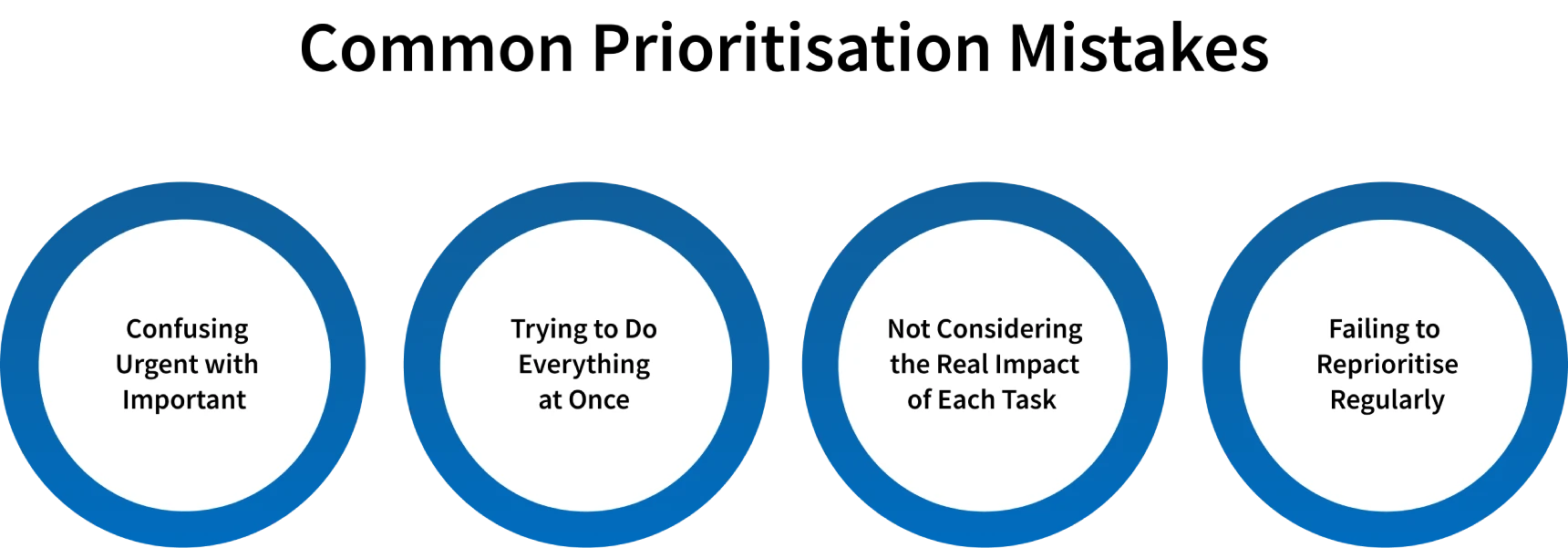
Confusing Urgent with Important
This is where a lot of people go wrong. A message pops up, or someone says they need something right now, and suddenly it feels like your top priority. But just because something seems urgent doesn’t mean it actually matters. Real improvement productivity starts when you can tell the difference between what grabs your attention and what actually helps you make progress. To get better at prioritising, stop before you react. Ask yourself: Is this really important, or just urgent and distracting?
Trying to Do Everything at Once
It might seem like doing many things at the same time helps you get more done, but it usually doesn’t. Your mind has to keep switching between tasks, and that takes extra time and energy. A better way to work is to choose a few important tasks and focus on finishing them one by one. Good task prioritisation is about staying focused, not trying to juggle everything. When you try to do too much at once, you often end up not finishing anything properly.
Not Considering the Real Impact of Each Task
Sometimes you spend hours working on things that keep you busy but don’t really help you move forward. Just because something takes time doesn’t mean it’s worth doing. If you want to get better at task prioritisation, focus on the tasks that actually make a difference. Do the work that brings real results, not just the stuff that fills up your day. That’s how you make real progress.
Failing to Reprioritise Regularly
Things change all the time. That’s just how work is. The mistake is assuming the list you made earlier will still work later. The mistake you are making is assuming the list you made earlier still works the same way later. It’s important to check your tasks often and make changes when needed. Whether you’re using a simple to-do list or any task prioritisation method, make time to review and adjust. What was important yesterday might not matter today, and that’s okay if you’re paying attention. Staying flexible helps you stay on track.
How BIXO Keeps Your Tasks Prioritised, Balanced, and On Track
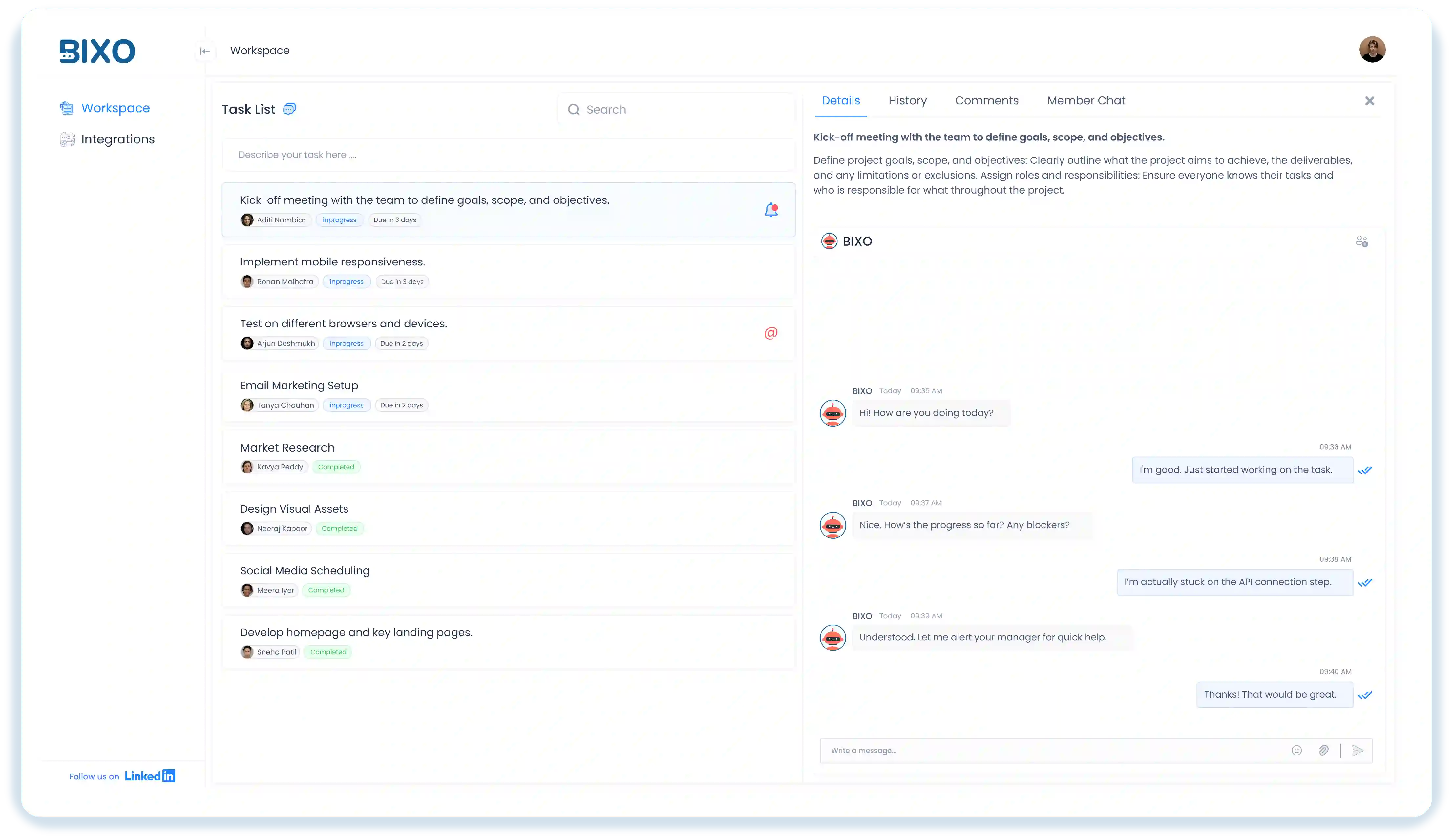
BIXO helps project managers stay focused on priorities by keeping them update with deadlines tracking, reminders, and task progress. When a task’s deadline, priority, or status changes, BIXO immediately notifies managers so everyone stays on the same page. Daily check-ins and end-of-day summaries make sure urgent work is clear without extra meetings.
BIXO keep important work on track by following up on tasks that are delayed or need attention. It also shows unassigned tasks and spots team members who aren’t busy, keeping workload planning balanced. All of this ensures important tasks get done, distractions are minimised, and your task management runs smoothly.
Conclusion
Knowing how to prioritise tasks helps you work smarter and get important things done without feeling work stress. When you focus on what really matters and use simple prioritisation methods, you can stay on track and manage your time better. By checking your priorities often, you can make steady progress every day. With clear task planning and prioritisation, you’ll always know what to do first, avoid distractions, and get more done with less effort.
FAQs
Start by making a list of everything you need to do. Once it’s all written down, it’s easier to see what’s important. Then choose a method like Ivy Lee or MIT to sort your tasks and stay on track.
Ask yourself if the task helps you make real progress or if you’re just doing it to avoid problems. Important tasks help you reach your goals. Urgent ones usually just come with pressure to act fast.
Start your day by deciding what really matters and working on those tasks first. Use simple methods like the Eisenhower matrix or MIT to prioritise the most important tasks. Avoid distractions, ask for help if you can, and check your progress often to make sure small or less important tasks don’t take up your time.
Pause for a minute, review your list, and shift things around. Don’t force an old plan to work. Real productivity means adjusting quickly and staying focused on what matters now.
Check in at the end of each day, or at least once a week. Plans change, so your task list should too. A quick review helps you stay aligned and avoid wasting time.
Get a demo of BIXO
Recommended Blogs
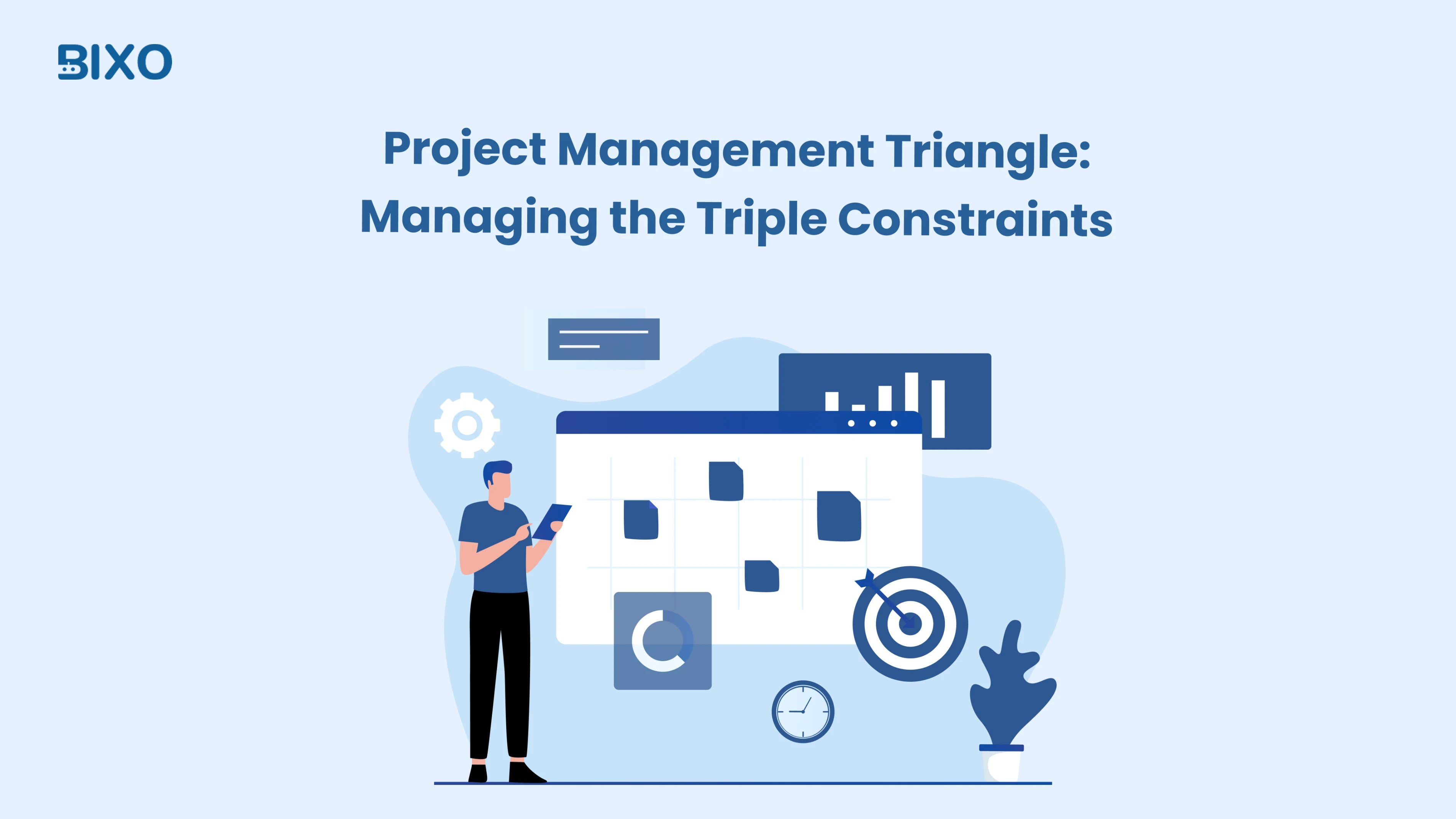
Project Management Triangle: Managing the Triple Constraints
Master the project management triangle by balancing scope, cost, and time with simple strategies that drive successful outcomes every time.
 Jahnavi Chintakrindhi |
Jahnavi Chintakrindhi |
 Oct 13, 2025
Oct 13, 2025

